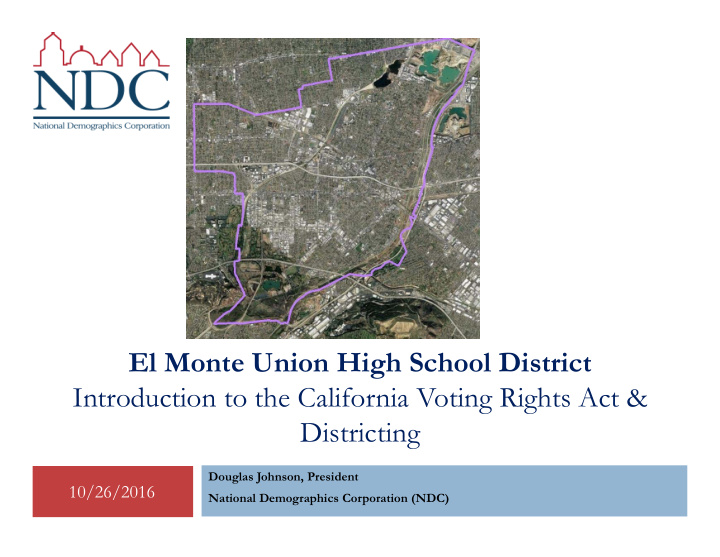



El Monte Union High School District Introduction to the California Voting Rights Act & Districting Douglas Johnson, President 10/26/2016 National Demographics Corporation (NDC)
CVRA Statewide Impact 2 Switched (or in the process of Key decisions & settlements switching) as a result of CVRA: Only Palmdale has gone to trial on the merits (the city lost) At least 135 school districts Key settlements: 27 Community College Districts Palmdale: $4.7 million 32 cities Modesto: $3 million 1 County Board of Supervisors Anaheim: $1.1 million (the last not-by-district County) Whittier: $1 million 8 water and other special districts. Santa Barbara: $600,000 Tulare Hospital: plaintiff attorneys paid $500,000 Madera Unified: plaintiff attorneys asked for $1.8 million, but received about $170,000 Hanford Joint Union Schools: $118,000 Merced City: $42,000 Placentia: $20,000 10/26/2016
Districting Process 3 10/26/2016
Typical School District Process 4 Date Action Step 1 Presentation on map-drawing criteria, process and demographics; Board consideration of Change and Criteria resolution(s), Board direction to start election waiver process Step 2 Initial Board hearing to discuss draft plans: Board direction on which maps to take to public forums. Board hearing on election waiver. Step 3 Public Forums on Draft maps (optional) Step 4 Board public hearing & adoption of Trustee Areas resolution Step 5 County Committee on School District Organization hearing and vote on Board- adopted trustee area map (Must be complete at least 125 days prior to 1 st by-area election date) Step 6 State Board of Education vote on election waiver Nov. 2017 or 18 First round of by-area elections Nov. 2019 or 20 Remaining trustee areas hold by-area elections 10/26/2016
AB350 Process (starting 2017) School Districts may not have to follow this process. 5 Date Action Step 1 Presentation on map-drawing criteria, process and demographics; Board consideration of Change and Criteria resolution(s), Board direction to start election waiver process Step 2 Two board public hearings to gather public input on what neighborhoods and other elements should be the focus and/or building blocks of draft maps Step 3 Initial Board hearing to discuss draft plans: Board direction on which maps to take to public forums. Separate Board hearing on election waiver. Step 4 Public Forums on Draft maps (optional) Step 5 Board two additional Board public hearings, followed by adoption of Trustee Areas resolution Step 6 County Committee on School District Organization hearing and vote on Board- adopted trustee area map (Must be complete at least 125 days prior to 1 st by-area election date) Step 7 State Board of Education vote on election waiver Nov. 2017 or 18 First round of by-area elections Nov. 2019 or 20 Remaining trustee areas hold by-area elections 10/26/2016
Community Engagement “3 E’s” 6 Engage the public 1. Educate the public 2. Empower the public 3. Public comment hopefully will include: Definitions of neighborhoods and “communities of interest” Suggesting individual districts or entire plans Sharing opinions on plans 10/26/2016
Districting Criteria 7 Federal Laws Traditional Redistricting Principles Communities of interest Equal Population Compact Federal Voting Rights Act Contiguous No Racial Gerrymandering Visible (Natural & man-made) boundaries Respect voters’ choices Planned future growth 10/26/2016
Defining Communities 8 There are many ways to define communities Best way to define a neighborhood remains to hear from the people who live there Some examples of communities of interest could include: School attendance areas; housing developments; neighborhoods around parks; horse-friendly neighborhoods Some communities want to be unified to maximize their voice in single election. Other communities (often school attendance areas and senior living communities) want to be divided so they have multiple representatives answering to them. 10/26/2016
Choosing the Map 9 The consultant typically draws 3 or 4 initial draft maps to help illustrate options and get the discussion going Members of the public can submit or request alternative options If there are a lot of maps under consideration, after at least one hearing the Board often narrows the list down to 2 or 3 – this enables the public to focus its input on the key maps under consideration It is often possible to ‘mix and match’ parts of different maps to arrive at a final map The selection of a District-preferred map is done by majority vote of the Board, followed by County Committee review and approval or disapproval 10/26/2016
Recommend
More recommend